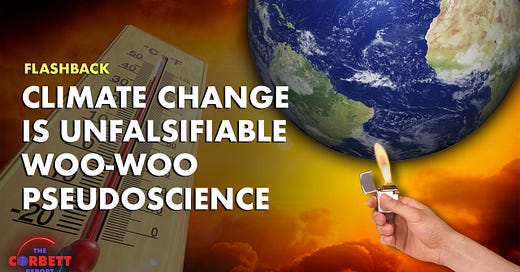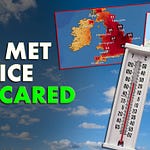SHOW NOTES: https://corbettreport.com/flashback-woowoo/
FROM 2015: Karl Popper famously said, “A theory that explains everything explains nothing.” So what do you make of the theory that catastrophic manmade CO2-driven “climate change” can account for harsher winters and lighter winters, more snow and less snow, droughts and floods, more hurricanes and less hurricanes, more rain and less rain, more malaria and less malaria, saltier seas and less salty seas, Antarctica ice melting and Antarctic ice gaining and dozens of other contradictions? Popper gave a name to “theories” like this: pseudoscience.
TRANSCRIPT
One of the giants in the history of the philosophy of science, Karl Popper, once famously observed that a theory that explains everything explains nothing.
And, to be sure, the theory of catastrophic anthropogenic climate change appears to explain everything.
After all, we all know that climate change makes for shorter winters . . . except for when it makes for harsher winters.
And climate change means less snow . . . except for when climate change means more snow.
And climate change causes droughts in California and floods in Texas and Oklahoma, and generally makes wet places wetter and dry places drier, except when it makes wet places drier and dry places wetter.
And climate change causes more hurricanes at the same time as it causes fewer hurricanes.
Climate change causes more rain, but less water? . . . And less rain, but more water?
Climate change decreases the spread of malaria at the same time as it increases the spread of malaria. (But don't worry! The Terminator himself advises us not to listen to those climate change cynics, hey guys?)
Do I need to go on?
Oh, OK.
Climate change makes San Francisco foggier.
Climate change makes San Francisco less foggy.
Climate change causes duller autumn leaves.
Climate changes causes more colourful autumn leaves.
Climate change makes for less salty seas.
Climate change makes for saltier seas.
Climate change causes the polar ice caps to melt.
Climate change causes the polar ice caps to freeze.
Climate change makes the earth hotter, unless the earth isn't getting hotter, in which case climate change can explain that, too!
What's the problem here? This sounds like the perfect scientific theory. It can explain literally everything, including self-contradictory things! This means it's absolutely perfect, isn't it?
Well, no, not according to Karl Popper and the philosophers of science.
And within the philosophy of science, there's something called the demarcation problem. How do you differentiate science from pseudoscience?
If you're at all interested in this, I would suggest you read through Karl Popper's Conjectures and Refutations, in which he lays out his criterion for differentiating science and pseudoscience, namely falsification.
What on earth does he mean by this?
Well, he starts with a very simple but very profound observation that people are attracted to pseudoscientific theories:
"[. . . b]y their apparent explanatory power. These theories appear to be able to explain practically everything that happened within the fields to which they referred. The study of any of them seemed to have the effect of an intellectual conversion or revelation, open your eyes to a new truth hidden from those not yet initiated. Once your eyes were thus opened you saw confirmed instances everywhere: the world was full of verifications of the theory. Whatever happened always confirmed it. Thus its truth appeared manifest; and unbelievers were clearly people who did not want to see the manifest truth."
And it occurred to him that although this is usually taken to be a good sign of a theory, "[i]t began to dawn on me [Karl Popper] that this apparent strength was in fact their weakness."
So he goes on to list his conclusions as to how we ultimately try to differentiate science from pseudoscience, and I think a couple of the most important conclusions here are:
4. A theory which is not refutable by an conceivable event is non-scientific. Irrefutability is not a virtue of a theory, as people often think but a vice.
And also:
7. Some genuinely testable theories, when found to be false, are still upheld by their admirers—for example by introducing ad hoc some auxiliary assumption, or by reinterpreting the theory ad hoc in such a way that it escapes refutation. Such a procedure is always possible, but it rescues the theory from refutation only at the price of destroying, or at least lowering, its scientific status.
And he sums it up by saying: "the criterion of the scientific status of a theory is its falsifiability, or refutability, or testability."
So, I would say that the ball is in the court of the believers of the catastrophic anthropogenic climate change hypothesis.
By what means can one falsify this hypothesis?
Let’s start with just an even lesser hurdle to come over: what set of observations over what period of time would be enough to refute the theory?
And then, furthermore, are there any actual hypotheses, any predictions that come as a result of this theory that can be tested against the real world, or real observations?
If the answer to that is no, then . . . well, you've got a word for your theory, and it's not science.
It's pseudoscience.
So again, the onus is on the believers in the catastrophic anthropogenic climate change hypothesis to come up with some way that you can test and potentially falsify this theory.
Because if you can't come up with any actual way to answer that question of how you falsify the theory, then you might as well just pray to your witch doctors to save you from the weather gods.
James Corbett, corbettreport.com.
Buy THE 2015 USB DATA ARCHIVE at NewWorldNextWeek.com, featuring every single podcast, interview, article and video published to The Corbett Report in 2015 (including this video!).












